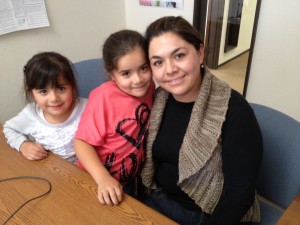But then Garibay learned that she qualified for Healthy Families. The federally subsidized program is for families whose incomes are just above the federal poverty level. Under Healthy Families, Garibay pays a total premium of $14 a month. It's a godsend for Garibay whose oldest daughter has a heart condition.
Garibay, through the interpreter, says "My daughter's been seeing the same cardiologist since she was three years old. Will she be able to see her same cardiologist when she switches to Medi-Cal?"
Children's Health Initiative manager Elba Gonzalez-Mares says she just doesn't know. Medi-Cal reimburses doctors at a lower rate than Healthy Families, so some doctors limit the number of Medi-Cal patients they take, or refuse to see them altogether.
Gonzales-Mares says she's been reassuring parents that their payments will be similar when the plan changes. But she hasn't been able to guarantee that their kids will be able to see the same doctors.
"The reaction is very upsetting," Gonzales-Mares says of the families. "They're concerned."
The state is ending Healthy Families as part of a budget deal between Governor Brown and Democratic lawmakers. It's designed to cut costs and save other health programs. Moving the nearly 900,000 kids in the Healthy Families program to Medi-Cal is expected to save $72 million a year by 2015.
Latino children make up nearly half the Healthy Families enrollees, and Gonzales-Mares worries they'll suffer the greatest disruptions in care. She says a survey of families the agency sees raises concerns about whether they'll understand that Healthy Families is ending.
"The Latino family, yes, they speak Spanish. But their literacy levels are very low, a third grade level," she says, "even in Spanish."
But Medi-Cal officials say the program is equipped to deal with the needs of Spanish speakers. Toby Douglas leads the state's Department of Health Care Services, which oversees Medi-Cal.
"Our proportion of individuals on the Medi-Cal program that are Spanish speaking or Latino descent are the same as those on Healthy Families," Douglas explains. "So it’s an essential component of our Medi-Cal program today."
Douglas says his office is working hard to make sure there will be enough doctors and specialists to treat these kids. "Close to 90 percent of the providers who participate in Healthy Families participate in the Medi-Cal program, and we believe that these providers will continue to see these children when they transition."
Douglas says under the federal health care overhaul, Medi-Cal reimbursement rates will rise significantly for two years, beginning this January.
But some pediatricians, like Napa pediatrician Victoria Morgese, are skeptical the state will maintain the higher rates when those federal funds go away. "The way I was raised, you can't get blood out of a turnip," she says. "If the money's not there, the money's not there."
Morgese is one of thousands of California doctors now forced to decide whether to keep her Healthy Families patients once they switch over to Medi-Cal. "My mentality is to take care of these people, to be a care provider," she says. "And yet, I have to take everything into consideration because I have to run a business!"
Morgese has more than 500 Healthy Families patients. She limits the number of Medi-Cal recipients to 10 percent of her patient load. Morgese says at current Medi-Cal reimbursement rates, she'd need to see three times the number of patients to keep the lights on.
"That means that the model of practice that we have set up here," she explains, "which is to spend a long time with our patients, to have a lower than average volume of patients per day in our office ... I wouldn't be able to do that."
Some children's health advocates are pushing for a delay to the transition. The four phase, year-long transfer is scheduled to begin in January.
